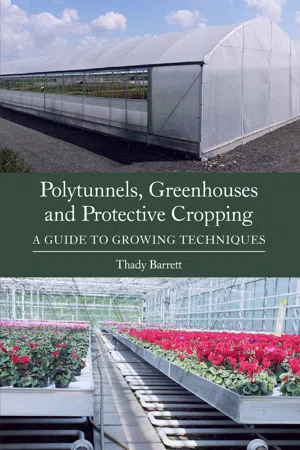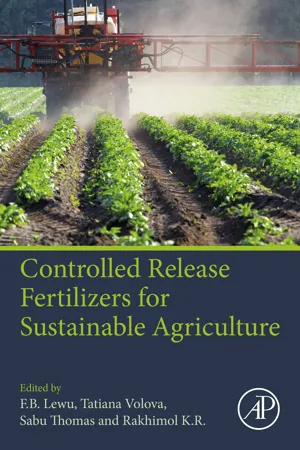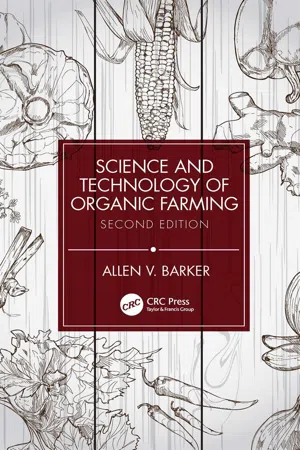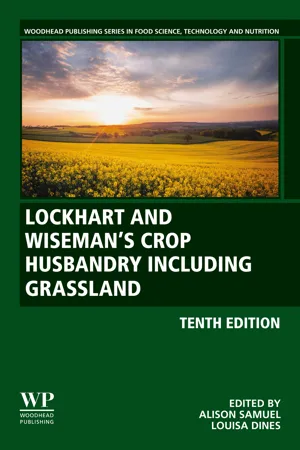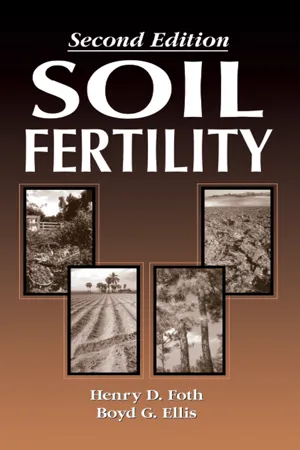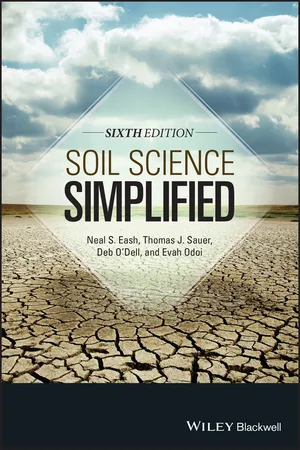Chemistry
NPK Fertilisers
NPK fertilizers are a type of fertilizer containing three primary nutrients: nitrogen (N), phosphorus (P), and potassium (K). These nutrients are essential for plant growth and are typically found in varying ratios in NPK fertilizers. Nitrogen supports leaf and stem growth, phosphorus aids in root development and flower/fruit production, and potassium helps with overall plant health and disease resistance.
Written by Perlego with AI-assistance
Related key terms
9 Key excerpts on "NPK Fertilisers"
- eBook - ePub
- Charles Adams, Mike Early, Jane Brook, Katherine Bamford(Authors)
- 2014(Publication Date)
- Routledge(Publisher)
5 .▶ Potash fertilizers provide the element potassium and given as % K; the ‘old’ name for potassium is ‘Kalium’; and more usually in Britain and Ireland described in terms of ‘equivalent amount of potassium oxide’, i.e. %K2 O.▶ Magnesium fertilizers are described in terms of %Mg.The percentage figures show the quantities of nutrient in each 100 kg of fertilizer – for example, ammonium sulphate is 20% N so there is 20 kg of the element nitrogen in every 100 kg of the fertilizer so by proportion there is 5 kg in a 25 kg bag or 1 kg in a 5 kg bag.Fertilizers are a concentrated source of nutrients as illustrated by the following materials that supply the element nitrogen (N) – for example: 1kg N is supplied in a 5kg bag of ammonium sulphate. 1kg N is supplied in 2–5 tonnes of fresh farmyard manure. i.e., the nutrients in bulky organic matter are more diluted (or non-existent).Besides the major nutrient content, fertilizer regulations require that details of trace elements, pesticide content and phosphorus solubility should appear on the packaging. For organic gardening it is necessary to look at specific requirements including the limitations on fertilizer use.There are many different types of fertilizers in terms of their▶ content (straight/compound)▶ formulation (granules/powders, quick/slow/controlled release)▶ the ways they are used (base/top dressing, liquid feed, foliar feed).Straight fertilizers are those that supply only one of the major nutrients: nitrogen, phosphorus, potassium or magnesium such as ammonium sulphate (supplying N), triple superphosphate (P), potassium chloride (K).Compound fertilizers are those that supply two or more of the nutrients nitrogen, phosphorus and potassium, such as Growmore. The accepted convention for describing the fertilizer content of compounds is to label the content in the order N P K so Growmore is described as 7:7:7, that is, 7% N: 7% P2 O5 : 7% K2 O. Most of the proprietary fertilizers for gardeners are compounds including those specifically for tomatoes, roses, orchids and cacti (see Figure 14.7 - eBook - ePub
Polytunnels, Greenhouses and Protective Cropping
A Guide to Growing Techniques
- Thady Barrett(Author)
- 2016(Publication Date)
- Crowood(Publisher)
11Fertilizers for Greenhouse CropsFertilizers refer to any material containing macro- and micronutrients that are used to supplement what already exists in the growing media, either before or after planting. Base fertilizer dressings are applied to correct nutrient status before cropping in both soil sand soilless systems, usually in a solid form. Subsequent fertilizer application may be made by top dressing as for field vegetables and long-term container crops, by liquid feeding and/or fertigation (feeding with every watering) and by foliar applications to instantly correct nutrient deficiencies of plants.Fertilizers are derived from a number of sources:- Mined rock, which is common for phosphates, calcium, magnesium and potassium
- Synthetic, as for many nitrogen fertilizers
- Organic sources, which could be waste product from food production such a ‘blood, fish and bone’
Fertilizers come as solids, simple granules, soluble granules, coated pellets (control release) and liquids. Synthetically produced fertilizers tend to come with higher concentrations of individual nutrients that are instantly available; this is in comparison to many organic fertilizers that need to be broken down by micro-organisms before releasing the nutrients required for plant growth.All fertilizers dissociate themselves in the soil into positive and negative ions, which are then taken up by plant root systems – for example, calcium nitrate Ca(NO3 )2 will dissociate into cation Ca2+ and .PLANT NUTRIENTSThe three major nutrients are nitrogen (N), phosphorous (P) and potassium (K), and they are required in large quantities that need to be delivered in different proportions during the lifetime of the crops. These are sometimes referred to as primary macronutrients, but the plant also needs to find significant reserves of secondary macronutrients Ca, Mg and S.Micronutrients are those essential nutrients that plants require in small amounts, such as Fe, Mn, Zn, Cu, B and Mo. Beyond that, plants take up a vast array of nutrients available in soils and may be adapted to local conditions, or genetically adapted to exploit certain elements, such as grasses and bamboos, which take up silica to enhance cell wall strength. - F.B Lewu, Tatiana Volova, Sabu Thomas, R.K. Rakhimol(Authors)
- 2020(Publication Date)
- Academic Press(Publisher)
56 ].Most of the inorganic fertilizers influencing the growth and development of plants are NPK fertilizers that are rich in macronutrients nitrogen (N), phosphorus (P), and potassium (K). Moreover fertilizers also supplement minor nutrients like calcium, sulfur, magnesium to enhance the soil fertility. The fertilizer industries are the major contributors of outdoor terrestrial natural radionuclides ( 238 U, 232 Th, and 210 Po) and heavy metals (Hg, Cd, As, Pb, Cu, Ni, and Cu) as potential sources [22 ,57 ]. The factory workers associated with the production of fertilizers and farmers involved in direct application of fertilizers are exposed to ionizing radiations from these radionuclides. The long-term exposure of such radiations released from fertilizers has a potential to trigger cancers in humans [57 ]; hence, international awareness about such radiation hazards should be taken into consideration.Over the past decades, chemical fertilization increased exponentially throughout the world causing serious environmental pollution and health hazards. This leads to the deterioration of soils' natural properties and fertility, accumulation of heavy metals in plant tissues, compromising the nutritional value of fruits and other crops [55 ]. Although chemical/synthetic fertilizers have been claimed to be the most important contributor to the world's agricultural productivity [58 ], their negative effects on environment and humans limit its usage in sustainable agricultural systems [47 ]. Hence, it is mandatory to gain a detailed knowledge about the chemistry and journey of agropollutants from soils to ecosystems and from crops to its dependent food chains via absorption from soil. These toxic agropollutants persist in the soil and leach into water sources causing serious environmental issues like increasing the rate of eutrophication, loss of biodiversity, ozone layer depletion, global warming, ground water pollution, and threatening of the future food security, thus, leading to health problems [10- Thanks to legislation going back to the Fertilizers and Feedstuffs Act in the late 1800s, anything sold as a fertilizer has to have its content in terms of percentage plant nutrients prominently displayed, and the major nutrients always listed in the order NPK. When reading the label on a pack of tomato fertilizer, however, it appears that there is more to this than initially meets the eye. Thus the element nitrogen is frequently provided in three forms: nitrate, urea or ammonia. Depending on the fertilizer, it may contain nitrogen in just one or all three of these forms, in which case the label will give a percentage figure for total nitrogen, plus an additional breakdown of the components.The content of the element phosphorus is expressed in terms of phosphorus pentoxide soluble in water; potassium content is expressed in the form of potassium oxide. If included, the minor and trace nutrients are usually listed just using their chemical symbol. The major nutrients are also expressed in ratio form, which allows easy comparisons between different fertilizer brands. For example, the old allotment favourite National Growmore (introduced as part of the ‘Dig for Victory’ campaign, and still going strong) is a general purpose compound fertilizer containing 7 per cent N, 7 per cent P and 7 per cent K. This is also known as a 1:1:1, describing the ratio of nutrients to each other.The requirement for mineral nutrients differs according to both the plant and the plant’s stage of development. Back in the 1920s it was shown that in one season a greenhouse-grown tomato crop extracted four and a half times the amount of nitrogen from the soil than phosphate, and a massive nine times the amount of potassium.Before concluding that the ideal tomato fertilizer should contain nutrients in these ratios, it should be noted that much of the nitrogen is needed in the initial vegetative growth stage, whereas most of the potassium is used when the plants are bearing heavy loads of fruit. This gives a case for using two different fertilizer combinations, one higher in nitrogen for the early stages of the crop, followed by one higher in potassium for the main fruiting season.
- eBook - ePub
- Allen V. Barker(Author)
- 2021(Publication Date)
- CRC Press(Publisher)
Severe shortages of nutrients usually lead to the development of symptoms of deficiency. Recognition of these symptoms is a useful way of identifying nutritional disorders in a crop. If the deficiency is detected in time, fertilization may restore crop productivity. If the deficiency is recognized too late for correction in the current crop, the grower is alerted that remedies need to be taken for the next season.Fertilizers are materials that carry plant nutrients to the soil or directly to crops. This chapter will present and evaluate organic and chemical fertilizers for each of the plant nutrients and will discuss practices that increase the nutrient-supplying capacity of soil.Nitrogen
Functions
The discovery of the essentiality of nitrogen is attributed to Theodore de Saussure, who in 1804 published his research that showed that normal growth of plants was not possible without the absorption of nitrates and other minerals from the soil. Nitrogen has many functions in plants. It is a component of proteins, genetic material (the nucleic acids, DNA and RNA), chlorophyll, and many other compounds that are vital in plant metabolism. Proteins are nitrogen-rich compounds and are major nitrogenous constituents of plants. By weight, about one part in six (16%) of the average protein molecule is nitrogen. About 85% or more of the nitrogen in plants is in protein. Another 10% of the total nitrogen in plants is in soluble nitrogenous compounds, such as uncombined amino acids and unassimilated nitrate and ammonium. The remaining 5% or less of the total nitrogen is in the genetic material, chlorophyll, coenzymes of metabolism (vitamins and the like), and lipids, among other compounds.Effects of Nitrogen on Plant Growth and Quality
Nitrogen is a potent nutrient, the deficiency of which can limit crop production severely. Application of nitrogen fertilizers must be monitored closely to avoid under-fertilization or over-fertilization. Nitrogen is deficient in about 70% of crop land. Recovery of growth and yield potential from nitrogen deficiency during resupply of the nutrient can be rapid; however, over-application of nitrogen may have adverse effects on growth and quality. Some of the effects of limited, optimum, and excessive nitrogen fertilization follow. - Alison Samuel, Louisa Dines, Steve Finch, Gerry P. Lane(Authors)
- 2022(Publication Date)
- Woodhead Publishing(Publisher)
4: Fertilisers and manures
Abstract
This chapter explains the importance of optimising plant nutrition and soil fertility for crop production. It discusses the main plant food elements required by crops, both major nutrients and micronutrients (trace elements). It describes the fertiliser materials used on-farm and explains the differences between straights, compounds, complexes and blends, as well as considering application practices and methods for both solid and liquid fertilisers. Organic materials, both produced on- and off-farm are valuable nutrient sources for crop production and can often be additionally beneficial as soil conditioning agents. Livestock manures and slurries, together with a range of other organic materials, are described in terms of their characteristics and best use. Finally, the chapter considers the effect of fertilisers and manures on the wider environment.Keywords
Compound; Fertiliser; Nitrogen; Nutrient; Organic material; Phosphorus; Potassium; Straight4.1. Introduction
Good nutrient management is a key aspect of viable and sustainable agricultural production. There is the challenge of increasing food production for the growing global population whilst ensuring that environmental impacts are lessened. Supplying optimal levels of nutrients for crop and livestock production as part of profitable farming businesses involves extensive decision making associated with the importance of integrated farming systems and their connection with the wider environment including the abiotic considerations of soil, water and air linked to the biotic aspects of habitats, biodiversity and species.For viable field crop production, in terms of economic yield and good crop quality, nutrients should be readily available so that uptake is optimised and both nutrient deficits limiting uptake and nutrient excesses that may cause losses to the environment are reduced. Nutrient removals off the field as a result of crop harvest should be considered in nutrient budgeting calculations and decisions so that nutrient inputs help to reduce any nutrient gaps in the system and soil available nutrient levels are maintained at an optimum level that suit both effective cropping and a better environment. An assessment of nutrient budgeting considers at a basic level both crop nutrient supply and harvest offtake, but in more detailed assessments can include all nutrient additions to the soil supplying the crop and all nutrient outputs including to the wider environment away from the crop. It is important that any nutrient supply system minimises the loss of nutrients to the environment as well as avoiding either a deficiency or an excess of individual, required nutrient elements. There are additional factors associated with local soil characteristics, nutrient behaviour and effects of weather and climate that should also be part of any nutrient decision-making process.- eBook - ePub
- Boyd Ellis, Henry Foth(Authors)
- 2018(Publication Date)
- CRC Press(Publisher)
11 Nitrogen, Phosphorus, and Potassium FertilizersThe fertilizer industry developed in stages with phosphate materials in the 1840s, potassium materials in the 1870s, and the nitrogen materials about 1900. More recently, micronutrient fertilizers have been developed.Overall soil fertility in the U.S. has been increasing, and in many Instances the application of only one nutrient is desirable. Improvements and greater use of soil tests have helped identify these situations. As a result, the use of single-nutrient carriers for direct application to the soil, relative to use of mixtures, has been increasing. Actually, the application of both kinds of fertilizers have been increasing. In 1976, the direct application of single carrier fertilizers surpassed the use of mixtures or mixed fertilizers.11.1 NITROGEN FERTILIZERSManure was the dominant fertilizer for thousands of years in areas where animals were used for power and food. Most of the nutrients in feed appear in the manure, and If the manure is efficiently managed, it can be very effective in the maintenance of soil fertility. Peruvian guano was the first fertilizer imported into the U.S. In 1824. This organic fertilizer consisted of the excreta and remains of birds whose primary diet consisted of fish. Guano contains about 13% N, which is mostly organic. In 1830, NaNO3 was imported from Chile. This inorganic material of natural origin contains about 16% N. These materials were used in the southern U.S. largely on specialty crops, such as cotton and tobacco. In the 19th century, the byproduct NH3 produced from the coking of coal used in steel manufacturing was neutralized with H2 SO4 to produce (NH4 )2 SO4 .11.1.1 The Major Nitrogen CarriersEconomics drives the production of N fertilizers toward the material or carrier that supplies N at the least cost. This carrier is anhydrous ammonia, NH3 , which contains 82% N. Its cost advantage is due to both low costs in production and in transportation, for NH3 is transported by pipeline. Two large pipelines transport NH3 from plants in Louisiana, Texas, and Arkansas to terminals as far west as Aurora, Nebraska, as far north as Garner, Iowa, and as far east as Huntington, Indiana. In 1965, NH4 NO3 was the second most popular carrier and urea was third. By 1978, there was greater consumption of urea than of NH4 NO3 in the U.S. These three carriers are the basis for making N solutions, which have increased steadily since 1965. These trends are shown in Figure 11.1 . Today, 95% or more of the N in fertilizers is produced by direct synthesis of NH3 - eBook - ePub
- Neal S. Eash, Thomas J. Sauer, Deb O'Dell, Evah Odoi, Mary C. Bratz(Authors)
- 2015(Publication Date)
- Wiley-Blackwell(Publisher)
Chapter 8 Soil Fertility and Plant NutritionWater, carbon dioxide, and certain chemical elements called plant nutrients are essential for plant growth. Water is supplied by either rainfall or irrigation, carbon dioxide from the atmosphere, and the essential plant nutrients from the soil, fertilizers, or other soil amendments.Soil Fertility
Soil fertility includes the ability of a soil to hold plant nutrients, the level of plant nutrients present, and the availability of the nutrients for uptake by plants. A soil that has a high level of essential nutrients available for use by plants is usually a productive soil if it also has sufficient soil water and if the crops are well managed. Plant nutrients exist in the soil in several different forms. They include the following:- Minerals. Examples include the feldspar group, which is the most abundant group of minerals in the rocks of the earth. Some are high in potassium and others in calcium. Nutrients are released from the minerals by weathering.
- Cations or anions. These are plant nutrients that exist on the surface of clay or humus. These surfaces are called the exchange complex and are positive or negative. They attract, hold, and exchange the cations or anions (see Chapter 5 ).
- Chemical compounds. There are many chemical compounds that form in the soil. An example would be the formation of phosphorus complexes on the surface of calcium carbonate.
- Soluble ions. Numerous ions exist in the soil solution. Plants absorb a large portion of their essential nutrients from this source. This pool of nutrients is small, but can be readily replenished through cation exchange reactions and other buffering mechanisms.
- Organic matter
- eBook - ePub
The Economics of Agro-Chemicals
An International Overview of Use Patterns, Technical and Institutional Determinants, Policies and Perspectives
- G.A.A. Wossink, G.C. van Kooten, G.H. Peters, G.A.A. Wossink, G.C. van Kooten, G.H. Peters(Authors)
- 2018(Publication Date)
- Routledge(Publisher)
There is some evidence that higher fertilizer prices in India resulted in more efficient use of fertilizers in irrigated areas because, despite an overall decline in fertilizer use in all three villages, crop production did not decline. This implies that farmers are moving towards applying recommended doses of fertilizers. A decline in fertilizer use occurred mainly in the case of phosphorus and potassium during the post-sowing stages. This did not cause any loss of welfare because phosphorus and potassium need not be applied in these stages. Although the use of fertilizers had, in general, declined, application levels were higher than recommended, especially in the irrigated villages. Other things remaining the same, farmers in the irrigated villages can still reduce the use of phosphorus and potassium. Further, the use of nitrogen has increased because of a continuation of subsidies, which are again leading to distortions in the supply of nutrients in balanced proportions. Despite the small sample, we believe that our conclusions apply to India as a whole.References
Agricultural Finance Corporation (AFC) (1991), Agricultural Development Project, Supporting Studies III: Sources of Past Growth , The Corporation, Bangalore.Chandran, Satish, T.R.S. (1993), Report of the Expert Committee: Stagnation of Agricultural Productivity in Karnataka in 1980s , Government of Karnataka, Bangalore.Hanumappa, H.G. and D. Rajasekhar (1994), Fertiliser Prices: Impact on Consumption and Cropping Pattern , ADRT Unit, Institute for Social and Economic Change (ISEC), Bangalore.Roy, S. (1990), Agriculture and Technology in Developing Countries: India and Nigeria , Sage, New Delhi.a Agricultural Development and Rural Transformation (ADRT) Unit, Institute for Social and Economic Change, Nagarbhavi, Bangalore – 560 072, India.Passage contains an image
8 An Economic Evaluation of Alternative Nutrient Management Practices in Sustaining Resource Base Productivity
R.P.S. MalikaIntroduction
The use of chemical fertilizers to replenish nutrient losses and raise crop productivity in intensive farming systems is well known, but there has been growing concern about the widespread use of chemical fertilizers as a means to restore, maintain or build up soil fertility, as some are coming to the conclusion that this does more harm than good and that such farming systems cannot be sustained in the long run. Ways of restoring the drained plant nutrients, which are healthy for the soil as well as the environment, are being increasingly emphasized.
Learn about this page
Index pages curate the most relevant extracts from our library of academic textbooks. They’ve been created using an in-house natural language model (NLM), each adding context and meaning to key research topics.

